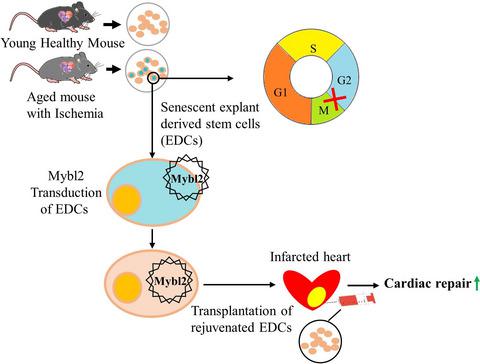当前位置:
X-MOL 学术
›
Aging Cell
›
论文详情
Our official English website, www.x-mol.net, welcomes your
feedback! (Note: you will need to create a separate account there.)
Mybl2 rejuvenates heart explant-derived cells from aged donors after myocardial infarction.
Aging Cell ( IF 8.0 ) Pub Date : 2020-06-19 , DOI: 10.1111/acel.13174 Ghazaleh Rafatian 1, 2 , Maryam Kamkar 2 , Sandrine Parent 1, 2 , Connor Michie 1, 2 , Yousef Risha 2 , André S D Molgat 2 , Richard Seymour 2 , Erik J Suuronen 1, 3 , Darryl R Davis 1, 2
Aging Cell ( IF 8.0 ) Pub Date : 2020-06-19 , DOI: 10.1111/acel.13174 Ghazaleh Rafatian 1, 2 , Maryam Kamkar 2 , Sandrine Parent 1, 2 , Connor Michie 1, 2 , Yousef Risha 2 , André S D Molgat 2 , Richard Seymour 2 , Erik J Suuronen 1, 3 , Darryl R Davis 1, 2
Affiliation

|
While cell therapy is emerging as a promising option for patients with ischemic cardiomyopathy (ICM), the influence of advanced donor age and a history of ischemic injury on the reparative performance of these cells are not well defined. As such, intrinsic changes that result from advanced donor age and ischemia are explored in hopes of identifying a molecular candidate capable of restoring the lost reparative potency of heart explant‐derived cells (EDCs) used in cell therapy. EDCs were cultured from myocardial biopsies obtained from young or old mice 4 weeks after randomization to experimental myocardial infarction or no intervention. Advanced donor age reduces cell yield while increasing cell senescence and the secretion of senescence‐associated cytokines. A history of ischemic injury magnifies these effects as cells are more senescent and have lower antioxidant reserves. Consistent with these effects, intramyocardial injection of EDCs from aged ischemic donors provided less cell‐mediated cardiac repair. A transcriptome comparison of ICM EDCs shows aging modifies many of the pathways responsible for effective cell cycle control and DNA damage/repair. Over‐expression of the barely explored antisenescent transcription factor, Mybl2, in EDCs from aged ICM donors reduces cell senescence while conferring salutary effects on antioxidant activity and paracrine production. In vivo, we observed an increase in cell retention and vasculogenesis after treatment with Mybl2‐over‐expressing EDCs which improved heart function in infarcted recipient hearts. In conclusion, Mybl2 over‐expression rejuvenates senescent EDCs sourced from aged ICM donors to confer cell‐mediated effects comparable to cells from young nonischemic donors.
中文翻译:

Mybl2可使心肌梗死后的老年供体的心脏外植体细胞恢复活力。
尽管细胞疗法已成为缺血性心肌病(ICM)患者的一种有前途的选择,但供体年龄的增长和缺血性损伤史对这些细胞修复性能的影响尚不明确。因此,探索了由于供体年龄增加和局部缺血导致的内在变化,以期希望找到能够恢复细胞疗法中心脏外源性细胞(EDC)丧失的修复能力的分子候选物。在随机分配至实验性心肌梗塞或无干预后4周,从幼鼠或老年小鼠的心肌活检物中培养EDC。较高的供体年龄会降低细胞产量,同时增加细胞衰老和衰老相关细胞因子的分泌。缺血性损伤的历史会放大这些作用,因为细胞会衰老,抗氧化剂储备较低。与这些作用一致,来自老年缺血供体的心肌内注射EDC提供的细胞介导的心脏修复较少。ICM EDC的转录组比较显示,衰老修饰了许多有效细胞周期控制和DNA损伤/修复的途径。在来自老年ICM供体的EDC中几乎未开发的抗衰老转录因子Mybl2的过表达减少了细胞衰老,同时对抗氧化活性和旁分泌产物产生了有益的影响。在体内,我们观察到用Mybl2过表达的EDC治疗后细胞保留和血管生成的增加,这改善了梗塞受体心脏的心脏功能。结论,
更新日期:2020-06-19
中文翻译:

Mybl2可使心肌梗死后的老年供体的心脏外植体细胞恢复活力。
尽管细胞疗法已成为缺血性心肌病(ICM)患者的一种有前途的选择,但供体年龄的增长和缺血性损伤史对这些细胞修复性能的影响尚不明确。因此,探索了由于供体年龄增加和局部缺血导致的内在变化,以期希望找到能够恢复细胞疗法中心脏外源性细胞(EDC)丧失的修复能力的分子候选物。在随机分配至实验性心肌梗塞或无干预后4周,从幼鼠或老年小鼠的心肌活检物中培养EDC。较高的供体年龄会降低细胞产量,同时增加细胞衰老和衰老相关细胞因子的分泌。缺血性损伤的历史会放大这些作用,因为细胞会衰老,抗氧化剂储备较低。与这些作用一致,来自老年缺血供体的心肌内注射EDC提供的细胞介导的心脏修复较少。ICM EDC的转录组比较显示,衰老修饰了许多有效细胞周期控制和DNA损伤/修复的途径。在来自老年ICM供体的EDC中几乎未开发的抗衰老转录因子Mybl2的过表达减少了细胞衰老,同时对抗氧化活性和旁分泌产物产生了有益的影响。在体内,我们观察到用Mybl2过表达的EDC治疗后细胞保留和血管生成的增加,这改善了梗塞受体心脏的心脏功能。结论,











































 京公网安备 11010802027423号
京公网安备 11010802027423号